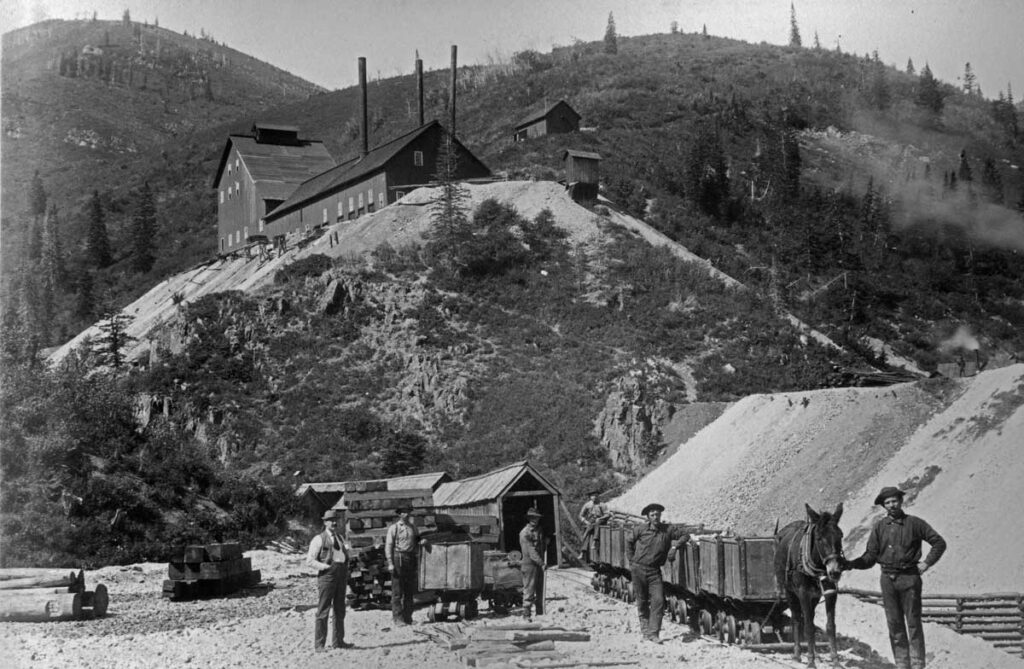This story is continued from January 31.
In 1889 the Anchor Mine hired two different drilling contractors to attempt a 600-foot long boring from the bottom of the flooded Anchor shaft to intersect with a drain tunnel being driven under the shaft location. The first contractor made two attempts to complete a 6-inch boring and failed. The second contractor attempted an 8-inch boring in 1890 but they also failed at a depth of 323 feet under the shaft. They then decided to connect an up-angled tunnel (known as a ‘raise’) from the drain tunnel under the shaft at the bottom of the 8-inch boring, so the water could be drained from the shaft via the boring into the raise and out the drain tunnel.
Work on the drain tunnel started in 1887 in lower Empire Canyon and proceeded well. A number of ore bodies were accessed from the tunnel while it was being driven, providing well-needed production for the mine. But the entire effort to drain the Anchor mine was plagued by bad luck. An avalanche took out the boarding house and some of the hoisting equipment at the intermediate shaft location along the route of the tunnel in 1888. The following year, the mine building at the same location was wrecked by a powder explosion. In January 1890 the main Anchor mine buildings and shaft hoisting works were destroyed in a fire, along with the drill rig that had just been mobilized to the mine. In January 1891 another avalanche damaged the boarding house at the mouth of the drain tunnel, injuring some of the workers.
The drain tunnel reached a point under the shaft in June 1889. It was 1,200 feet below the collar of the shaft meaning there was about 277 feet of solid rock between the bottom of the 8-inch boring (923 feet total depth) and the tunnel elevation. Work on the upward angled raise alongside the tunnel then commenced.
By March 1891, the end of the raise was about 250 feet above the tunnel, meaning it was close to the elevation of the bottom of the boring under the shaft. There was significant water flow into the raise and the water level in the shaft was dropping suggesting some water drainage was occurring through the intervening rock between the shaft and the raise, but the drainage was not fast enough.

Credit: Park City Historical Society & Museum, Diane W. & Richard D. Arner Collection
It was decided to try to increase the water flow into the raise by detonating explosives in the 8-inch boring to shake the surrounding rock some and hopefully increase the subsequent water flow into the raise. A “torpedo” containing 18 sticks of powder was lowered 300 feet into the boring but would not detonate. The second try detonated the torpedo in August 1891 but the water flow into the raise did not significantly change. The casing pipe for the boring was removed from the shaft in May 1891 to better open the boring to the water in the shaft only to find the boring was filled with sand.
Work continued driving the raise upward, along with driving multiple drifts (tunnels) from the raise toward the expected boring location without success in finding it. Additional surveys were made to help direct the location of the drifts to intersect with the boring. Miners finally intercepted the boring in October 1891, which allowed water in the shaft to quickly drain. The shaft was completely drained in November 1891. After some repairs, the shaft was later sunk to connect with the tunnel in August, 1892.
This completed a six-year saga of the Anchor Mine dealing with water and other challenges before it could get on with developing the mine to its full extent. The Anchor Mine became a major producer, comparable to the other large mines in the Park City District.
The drain tunnel was called the Anchor Tunnel when it was built. The Anchor Mine was acquired by the Daly-Judge Mining Company in 1902 and the drain tunnel is now called the Daly-Judge Tunnel. It is over 130 years old and is still maintained to produce water that is used by Park City. The tunnel portal is located next to the concrete-walled J.M.&S. Co. building in Empire Canyon.
A Park City Museum lecture given by University of Utah mining professor Mike Nelson on the Daly-Judge Tunnel water supply was moved to Wednesday, July 10.